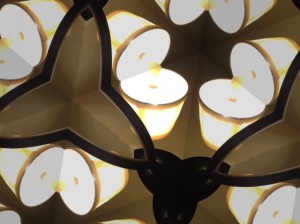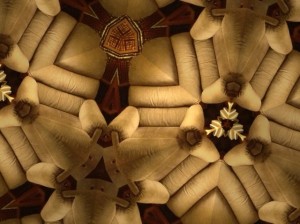Inspiring Interior Design (Part 9)
By Asher Crispe: August 16, 2012: Category Inspirations, Quilt of Translations
The Kabbalah of Furniture
A home is more than just empty rooms. We have spoken a great deal about the mystical characteristics of each room but we have yet to clarify the meaning of furniture. Much of the Torah (particularly in Jewish law) hyper-focuses on the nature of all objects that we encounter in the world. How can they be used in our spiritual service? How can they be elevated?
Kabbalah heightens this already extreme sensitivity, probing the esoteric dimensions of the mundane world and mining them for metaphysical insights. Thus, a chair is not a chair. More precisely, a chair is not merely a chair. All familiar objects act as anchors for metaphoric flights of thought. This is not coming under the aegis of platonism as a restatement of his doctrine of ideal forms. There may be an archetypal table but its purpose is not just to be the ideal essence, from which all other tables are imperfect replicas. Rather, there is something about the interconnection between the human subject and this physical object, the manner in which we experience ourselves using it not only for utility but in order to consecrate it. The chair becomes a meta-chair. Our drama a meta-drama. Our story a meta-narrative.
Furniture augments the room within which it is placed. Even repositioning furniture in the self-same room (without adding to or subtracting from its content) may drastically change its ambiance. Moreover, when our perspective on the room and the furnishings therein shifts, when we realign the observer (subject), observed (object, such as the chair) and context (room), the alteration can seem like an extreme make over. On a basic form and function level, the chair does not get to be a chair if it is never sat on (or minimally has the potential to serve as a seat). Approached from a ‘meta’ level, the meaning of this object must be disclosed within the horizon of Ultimate Reality. Somewhat akin to asking: ‘why did God create chairs?’ our criteria for comprehending the rhyme or reason for including any furnishing in our home must be assigned a holy (non-arbitrary) purpose.
Just as we were introduced to the concept of four archetypal rooms, so too we will get to know four archetypal pieces of furniture. Not that one’s home cannot have many more furnishings to it, but these are the bare essentials. When the clutter is striped away and the dust settles, these remain the basics for all time. Without them, a person cannot advertise a ‘furnished’ house.
In order to discover which items made the cut, we will need to look for a source in the Hebraic Bible. The ‘name talent’ and star of our furniture infomercial is none other than the illustrious prophet Elisha who receives the hospitality of an exceptional woman who will eventually give birth to her own son, the prophet Habakkuk, in the merit of this act. Following the Artscroll translation to Kings II 4:8-10 we see that her brilliance was not only to give Elisha a place to stay but also to supply him with our critical four items of furniture:
“It happened one day that Elisha traveled to Shunem. There was a prominent woman there and she importuned him to eat a meal; and so it was, whenever he passed by, he would turn in there to eat a meal. She [once] said to her husband, ‘Behold I know now that he is a holy man of God who passes us by regularly. Let us now make a small, walled attic and place there for him a bed, a table, a chair, and a lamp, [emphasis mine] so that whenever he comes to us, he can turn in there.’”
In his commentary on the writings of his father (Torat Menachem Tiferet Levi Yitzchok: Shemot p. 3-4), the Lubavitcher Rebbe deconstructs this passage and adds glosses and references to earlier strata of Zoharic interpretation that cover roughly the same ground.
Along the lines of our earlier treatment of the Temple as a ‘house of God (Havayah)’ or a housing of the letters Yud-Hei-Vav-Hei, he continues and equates all homes of Israel as having four essential furnishings (before we related these to the four rooms) which are parallel to the four letters of the Divine name: a bed, a table, a chair, and a lamp. Since they correspond to the letters of the Divine name that denotes Being or Reality, it follows once again that these items constitute the four modalities of Being or Reality. How does a bed represent a core facet of Reality? In what way does a table capture a way of Being?
In response to this the Rebbe joins a reading of the symbolic nature of these objects with a practical application that is pursuant to our optimal spiritual performance in the beatification of our homes (especially ourselves as dwellings for the Divine presence). Unlike other interpretations, he begins in the reverse of order in which they were named in the above passage.
First, the lamp or menorah functions as a source of light. Any experience of a room of the house has to start with illumination. A dark house, besides the obvious physical limitations it presents, ultimately embodies a negative spiritual environment. Disquieted by the darkness, the home loses its homeliness. It becomes foreign to us. Hostile. I am lost within it. I can’t find anything. Something might break. Whereas lighting restores my familiarity, assists in my orientation and navigation. A lamp scattering light throughout the room transmogrifies it’s character.
Citing Proverbs 6:23: “The candle [light source] is the performative [commandment or mitzvah], and the Torah is the light.” Each of our good deeds, every one of our righteous actions, all of our positive connections, install additional lamps and light fixtures in the home. Everything should be illuminated. Everything should be lit up with the light of the Torah (which itself is a cognate of the word for light in Hebrew ohr). The insights that we have into Being and Reality (the letter Yud which relates to chochmah) trace back to the Torah and its directives. Perhaps this is why a home emptied of all furnishings will still be required to retain its light fixtures. At the same time, any interior makeover should begin with enhancing the lighting (be it the lighting in our house or the light that we house within ourselves).
Second, we have the table (shulchan) which resembles the sacrificial altar. The purpose of the sacrifices (korbanot) was to draw closer (karov from the same root) to the Divine. This was a mechanism by which we could affect a restoration or return (teshuvah) to a sanctified relationship with God. A table in our home is always a place to eat. The food we partake of therefore must be integrated into ourselves in order to nourish us physically and spiritually. By extension, even a reading table is a place for the consumption of food for thought. Since these tables are spaces where consumables get dispensed, they relate to binah or understanding (the first Hei of the Divine name) which takes the not yet fully formed thoughts (chochmah) and lays them out for us, arranges them and provides utensils to aid with the ‘piecemealing’ as further analytic cuts can be required beyond the kitchen.
As most families know, there is nothing like bonding around the table. It’s the place to work out all of our issues, to come to terms and get closer to one another. If we want to develop mutual understanding (binah) for each other, then we have to sit at the same table. Every table is potentially a negotiating table. All parties must sacrifice something to be there. Hopefully, one of the most prominent light fixtures (the chandelier) shines directly above this table–then it will become a Torah table.
Third on our list is the chair (kisei). As is customary when a guest or traveler walks into one’s home, we spout something to the effect of ‘Why don’t you sit down and take a load off.’ The sitting position allows a person to remove the weight from their feet which normally are transporting us from place to place. Our legs and feet in Kabbalah, as an extension of self towards the earth, represent our bringing down and concretizing what we think and feel. They are the constant contact points that give a foundation to ourselves, a practical outlet and a connection to our surroundings. Since it is the Torah’s mandate that we impact the world arounds us, the legs and feet provide that link to external reality.
When it comes to doing a good deed (mitzvah) the Torah would like us to ‘run’ to do it. Sitting around might seem like a form of procrastination, but if the chair is linked to the inner meaning of the lamp and table, then it too ascends in holiness. Just as a battery needs to build up its charge before it can be put to work, the chair is not about rest and relaxation but rather about re-energizing ourselves. Since the chair lowers the head and body, while drawing the legs upward, it positions us in such a way that what we think and understand can now descend into our feelings and habits. When we have a new insight and take it in, we still have to let it sink in. This sinking in or situating of an experience allows for its emotional integration and acclimation. Thus, as we mentioned before, we need adequate emotional seating that will thereby let our feelings settle (six in all, like the Vav of the Divine name which equals six and relates the basic emotional states) around the table under the lamp.
Finally, the bed (mitah) draws the forth position. What happens to a body that is laying down? The bed puts us in the unique position of having our head and legs on the same level (assuming you don’t have a need for pillows). This horizontal orientation contrasts with our vertical standing which establishes a hierarchy of the head over the heart and over the legs. All of that stratification vaporizes in bed. The head, as leader of the body with all of its cognitive resources, no longer has elevated status over the lowest of the low: our feet.
Generally speaking, the feet don’t think and feel like the heart and head do. So the bed in some sense democratizes the control flow between action (feet/legs), emotion (heart/torso) and cognition (mind). It evens the playing field. The equalization of action, emotion and thought, according to the Rebbe, is the highest level of achievement. It transcends the normal working operations within the soul and fixes one’s nature such that all three centers of expression are holding the same way.
Self-expression, as we have mentioned before, relates to one’s kingdom (malchut, the final Hei of the Divine name). To be king in one’s kingdom means total self-mastery and complete control. If I am divided within myself so that my head wants to lead me in one direction and my heart in another, my actions will have to struggle with ‘whom’ to follow. Do I do what my brain tells me or do I follow my heart? Only when I act in concert with the same mind and heart can my actions come completely naturally. This sense of accomplishment is heard every time we say ‘let’s put this to bed.’
In Part Ten, we will continue with alternative interpretations of our furniture set.
http://www.interinclusion.org/inspirations/inspiring-interior-design-part-10/
Inspiring Interior Design (Part 9),

























;)
;)
;)
;)
;)
;)
;)
;)
;)
;)
